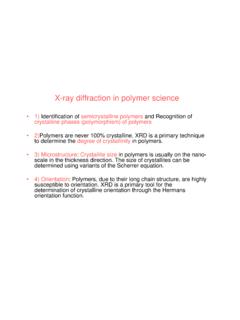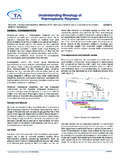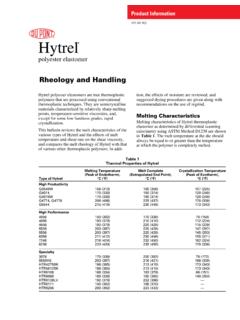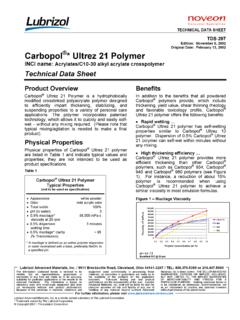Transcription of Rheology and Rheometry - PTG
1 Rheology and RheometryPaula MoldenaersDepartment of Chemical EngineeringKatholieke Universiteit LeuvenW. De Croylaan 46, B-3001 LeuvenTel. 32(0)16 322675 Fax 32(0)16 322991 = flowRheology= The Science of Deformation and FlowWhy do we need it?-measure fluid properties-understand structure-flow property relations-modelling flow behaviour-simulate flow behaviour of melts under processing conditionsProcessing conditions shear rate [s-1]Sedimentation10-6 10-4 Leveling10-3 Extrusion100-102 Chewing101 -102 Mixing101-103 Spraying, brushing103 -104 Rubbing104 -105 Injection molding 102 -105coating flows105-106 How about Newtonianbehaviour?1. Constant viscosity2. No time effects3. No normal stresses in shear flow4. (ext)/ (shear) = 3 Symbols: D Ts Newton s law: T = -pI + 2 DContents1. Rheologicalphenomena2. Constitutive Generalized Newtonian Linear Non-linear viscoelasticity3.
2 Rheometry4. Parameters affecting Phenomena:Do real melts behave according to Newton s law?Deviation 1:Mayonnaise: resistance (viscosity) decreases with increasing shear rate: shear thinningStarch solution: resistance increases with increasing shear rate: shear thickeningThis is a non-linearity:)( &Do real melts behave according to Newton s law?G(t) or G(t, )Deviation 2: example silly puttyThe response of the material depends on the time scale:* Short times: elastic like behaviour * Long times: liquid-like behaviourVISCO-ELASTIC BEHAVIOURt > t < Linear non-linear WeissenbergeffectDie SwellNormal stressesDo real melts behave according to Newton s law?Deviation 3:Do real melts behave according to Newton s law?deviation 4:Ductless Syphon (ext)> > (shear)In summary: Newtonian behaviour real behaviour1. Constant viscosity1. Variable viscosity2.
3 No time effects2. Time effects3. No normal stresses in shear flow3. Normal stresses4. (ext)/ (shear) = 34. Large (ext)3 dim: T = -pI + (2D)?Simple shear: = d /dtContents1. Rheologicalphenomena2. Constitutive Generalized Newtonian Linear Non-linear viscoelasticity3. Rheometry4. Parameters affecting rheology2. Constitutive Generalized Newtonian fluidsExamples of non-Newtonian behaviour:Macosko, Generalized Newtonian fluidsNon-Newtonian behaviour is typical for polymeric solutions and molten ABS polymer melt (Cox and Macosko) Generalized Newtonian fluidsDID2)II(fpT21 + =The viscosity is now replaced by a function of the second invariant of 2 Dfor a shear flow this becomes:and different forms for this function have been proposed() xy= 12&&With:II2D= 1/2 (tr22D tr (2D)2)tr = trace = sum of the diagonal elementsModel 1: Power Law1nnxy2/)1n(2kk2 IIkpT = = + ==&&DID2 parametersshear rate (s-1) , k=1n= , k=1n= , k= rate (s 1)020040060080010001200 050100150200250300n<1 : shear-thinningn>1: shear-thickeningModel 2: Ellis model() 0011111=+ =+ kIIknn&()3 parametersshear rate (s-1) 0n-1 Model 3.
4 CROSS model =+ 0111kn&()4 parametersshear rate (s-1)1e-31e-21e-11e+01e+11e+21e+31e+41e+ 5 0n-1log () =+ 0112212kIInD()/3 DSpecial case: plastic Behaviour < == > yyG&,&00No flow, only deformation Yield stressWhat have we gained in generalized Newtonian? Newtonian behaviourreal behaviour1. Constant viscosity2. No time effects2. Time effects3. No normal stresses in shear flow3. Normal stresses4. (ext)/ (shear) = 34. Large (ext)3 dim: T = -pI + (2D)T = -pI+ (II2D)(2D)Simple shear: = d /dtContents1. Rheologicalphenomena2. Constitutive Generalized Newtonian Linear Non-linear viscoelasticity3. Rheometry4. Parameters affecting rheology2. Constitutive Linear visco-elasticityReference: 2 extremesHooke s LawNewton s Law(solid mechanics)(fluid mechanics) = G. = .d /dtG = modulus (Pa) = viscosity ( )Material propertymaterial propertyTime effects (linear visco-elastic phenomena): Example 1: creepApply constant stress ComplianceJtt()()= 0 Time effects (linear visco-elastic phenomena):Example 2: stress relaxation upon step strainApply constant strainModulusG(t) = (t)/ Example for molten LDPE [Laun, Rheol.]
5 Acta, 17,1 (1978)]How to descibe this behaviour?Example: differential modelsPhenomenological modelsHookeanspringNewtonian dashpot101G = 202 = &MaxwellKelvin-Voigt =+===+=++ =+=12121210200000&&&&&&&&&GGMaxwell model: = relaxation time [rad/s] (t)024681012 G0 Example: Stress relaxation upon step strain for a Maxwell element = +===== 0000000tddttGtGtGt;()()exp(/)Generalized Maxwell model to describe molten polymers: TOTiiiiiiiiiGtGt= +== &&()exp(/)0 Relaxation functions:For a simple Maxwell model: single exponential (single relaxation time ):GtGtGtGtGtFtdGtHtdii()exp(/)()exp(/)() ()exp()()exp= = = = 000 For a generalized Maxwell fluid (discrete number of relaxation times I:We can replace the discrete relaxation times by a continuous spectrum:Or based on alogaritmictime scale : the relaxation spectrum is defined by:Time effects (linear visco-elastic phenomena): Example 3: Oscillatory experimentsSTRAINtitSTRAINRATE ttitHOOKEANSOLIDGGtGitNEWTONIANFLUID tiiti.)
6 Sin()exp()&cos()sin()&iexp()sin()exp()&s in()exp() ====+ ======+ ==0000000009090[]()()[]VISCOELASTICMATER IALGiGicomplexulusGGtGttGtGtGtGtGiGelvis c =+=+=+==+=+= + = + =+ ()mod:sin()sin().cos()cos().sin()cos()si n()sin()cos()'sin()"cos()('")00000 Storage and Loss modulustan''' =GGDynamic moduli of a Maxwell fluidw [rad/s] [Pa] 'G"G0 GGGG'()"() =+=+0222202211G and G for a generalized Maxwell fluid:GGssdsGesdsGGGssdsGiisiNiiiiNiiiiN "()cos()cos()()'()sin()()()= = =+= =+ = = = 01021022111 What have we gained in linear visco-elasticity? Newtonian behaviour real behaviour1. Constant viscosity1. Variable viscosity2. No time effects2. Time effects3. No normal stresses in shear flow3. Normal stresses4. (ext)/ (shear) = 34. Large (ext)3 dim: T = -pI + (2D)G(t), H( ).
7 Simple shear: = d /dtfully descibeslinear VEContents1. Rheologicalphenomena2. Constitutive Generalized Newtonian Linear Non-linear viscoelasticity3. Rheometry4. Parameters affecting rheology2. Constitutive Non-linear visco-elasticityExample 1: Steady state shear flow 2221 &&&zzyyyyxxxy = = =zzyyyyxxxyNN = =21 LDPE, Laun et in decalin, Keentok et 2: Non-linear stress relaxation upon step strain LDPE, Laun et 3: Stress evolution upon inception of shear or elongationalflow What have we gained in non-linear visco-elasticity? Newtonian behaviour real behaviour1. Constant viscosity1. Variable viscosity2. No time effects2. Time effects3. No normal stresses in shear flow3. Normal stresses4. (ext)/ (shear) = 34. Large (ext)3 dim: T = -pI + (2D)no universal modelSimple shear: = d /dtContents1. Rheologicalphenomena2. Constitutive Generalized Newtonian Linear Non-linear viscoelasticity3.
8 Rheometry4. Parameters affecting ?1. Input for Constitutive Equations2. Quality control3. Simulate industrial flowsA rheometer is an instrument that measures both stress and deformation. indexer viscometer What do we want to measure?-steady state data-small strain (LVE) functions-large strain deformationsIntroduction: classifications Kinematics : shear vs elongation homogeneous vs non-homogeneous vscomplex flow fields type of straining:-small : G ( ), G ( ), +(t), -(t), G(t), y-large: G ( , ), G ( , ), +(t, ), -(t , ), G(t , ), (t, )-steady : ( ), 1( ) shear Rheometry : Drag or pressure driven & Shear flow geometriesPressure driven flowsDrag flowsSliding platesCouetteCone and PlateParallel platesCapillarySlitAnnulusMacosko, 1992 Drag flows : Cone and plate ()()rrrrrvrrrrrrrrr::sinsincot:cot110120 222 += =+ =Probably most popular geometry Mooney (1934)1.
9 Steady, laminar, isothermal flow2. Negligible gravity and end effects3. Spherical boundary liquid4. vr=vz=0 and v (r, )5. Angle < radiansEquations of motion:Drag flows : Cone and plate geometryBoundary conditions1. v ( /2) = 02. v ( /2- )= rsin( /2- ) rShear stress() :cotsin12032220023rddrCCteMrdrdMrR+ = = = = Independent of fluid characteristics because of small angle!Drag flows : Cone and plate geometryShear rate: is also constant throughout the sample: homogeneous!&()()() == = vhrrrtgtgrNormal stress differences: total trust on the plate is measured Fz()FRNzFRz= = 21222 Drag flows : Cone and plate geometry+-constant shear rate, constant shear stress -homogeneous!-most useful properties can be measured-both for high and low viscosity fluids-small sample-easy to fill and clean--high visc: shear fracture -limits max.
10 Shear rate-(low visc: centrifugal effects/inertia -limits max. shear rate)-(settling can be a problem)-(solvent evaporation)-stiff transducer for normal stress measurements-viscous heatingDrag flows : Parallel platesAgain proposed by Mooney (1934)1. Steady, laminar, isothermal flow2. Negligible gravity and end effects3. cylindrical edge4. vr=vz=0 and v (r,z)Equations of motion:()()()rrrrrvrzzzrrzzz:::1002 = ==Drag flows : Parallel platesShear rate: is not constant throughout the sample& == vhrhrShear stress =+ MRdMdR213lnln&Normal stressesNNFRdFzdzR1222 =+ lnln&Drag flows : Parallel plate geometry+-preferred geometry for viscous melts -small strain functions-sample preparation is much simpler-shear rate and strain can be changed also by changing h-determination of wall slip easy-N2when N1is known-edge fracture can be delayed--non-homogeneous flow field (correctable)-inertia/secondary flow -limits max.






